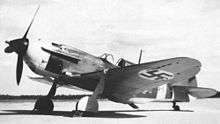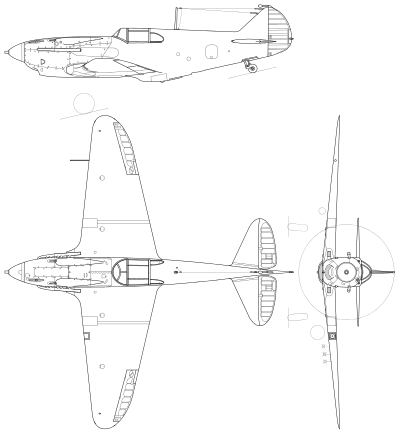Lavochkin-Gorbunov-Gudkov LaGG-3
| LaGG-3 | |
|---|---|
 | |
| A series 66 LaGG-3 before taking off | |
| Role | Fighter |
| Manufacturer | 21 (Gorky), 31 (Taganrog/Tbilisi), 23/153 (Leningrad/Novosibirsk) |
| Designer | V. P. Gorbunov |
| First flight | 28 March 1940 |
| Introduction | early 1941 |
| Retired | 1944 |
| Primary user | Soviet Union |
| Produced | 1941–1944 |
| Number built | 6,528 |
| Variants | Lavochkin La-5 Lavochkin La-7 |
The Lavochkin-Gorbunov-Gudkov LaGG-3 (Лавочкин-Горбунов-Гудков ЛаГГ-3) was a Soviet fighter aircraft of World War II. It was a refinement of the earlier LaGG-1, and was one of the most modern aircraft available to the Soviet Air Force at the time of Germany's invasion in 1941.
Overweight despite its wooden construction, at one stage 12 LaGG-3s were being completed daily and 6,528 had been built when factory 31 in Tbilisi switched to Yak-3 production in 1944.[1]
Design and development
The prototype of the LaGG-3, I-301, was designed by Semyon A. Lavochkin, Vladimir P. Gorbunov and Mikhail I. Gudkov. It was designated LaGG-3 in serial production. Its airframe was partially made of wood delta-veneer (a resin-wood multi-ply veneer composed of very thin, 0.35 to 0.55 mm, wood veneer and phenol formaldehyde resin, baked at high temperature and pressure) used for the crucial parts. This novel construction material had tensile strength comparable to that of non-hardened aluminum alloys and only 30% lower than that of precipitation hardened D-1A grade duralumin. It was also incombustible and completely invulnerable to rot, with service life measured in decades in adverse conditions. The full wooden wing (with plywood surfaces) was analogous to that of the Yak-1. The only difference was that the LaGG's wings were built in two sections. The fuselage was of similar construction to the MiG-3's.[2] The LaGG-3's armament consisted of a 20 mm ShVAK cannon, with 150 rounds, which was installed as the motornaya pushka (моторная пушка - motor cannon) in the cylinder block split- between the "V" of the engine cylinders and firing through a hollow propeller shaft, and two synchronized 12.7 mm Berezin UBS machine guns with 170 rpg. Consequently, the combined weight of rounds fired per second was 2.65 kg/s, making the LaGG-3 superior in burst mass to all contemporary Russian fighters, particularly to the MiG-3.[2] Most other Russian fighters of that era were considered under-gunned in relation to western contemporary fighters. This is somewhat true even for the Yak-1, which had a 20 mm cannon and two 7.62 mm machine guns, but not the later versions of the Polikarpov I-16, which had two cannons and two machine guns.
Operational history
The LaGG-3 rapidly replaced the LaGG-1. The first LaGG-3 rolled out from Factory no. 23 in Leningrad and was tested in December 1940. As soon they were built, the first aircraft were sent to their units in Soviet Asia.[3] There, the new fighter proved clearly underpowered. It was too heavy for its engine. In fact, Lavochkin, Gorbunov and Gudkov had originally designed their prototype for the powerful Klimov M-106 engine, but it proved to be unreliable, so they were obliged to install the relatively weak Klimov M-105P. As a result, the LaGG was slow: its top speed was just 360 mph at 16,500 feet, while getting to that height took an excessively long time: 6.8 minutes,[3] its rate of climb, at ground level, being as slow as 8.5 meters/second.
The LaGG-3 proved immensely unpopular with pilots. It was somewhat hard to control as it reacted sluggishly to stick forces. In particular, it was difficult to pull out of a dive, and if the stick was pulled too hard, it tended to fall into a spin. As a consequence, sharp turns were difficult to perform.[2] Moreover, pilots reported a number of imperfections: badly made hydraulic systems, broken connecting rods, oil leaks, overheating engine. Moreover, the landing gear was defective, the tail wheel easily broke, the canopy was badly fitted, the metal sheet on the engine cowling and the stressed skin were badly finished.[3] This happened less because of the added weight with full fuel and weapon loads in combat conditions, but specifically to the poor finishing in rushed industrial production, due to the German invasion.
As reports of these problems came back to Lavochkin's Experimental Design Bureau (OKB), in February 1941, not less than 2,228 modifications were ordered to be introduced into the series.[3] Actually, despite the military's doubts, Soviet government ordered 66 batches of the Lavochkin fighter, which underwent a host of successive improvements in engines, propeller and armament.[3] The airframe as well was lightened. The LaGG team re-examined the design and pared down the structure as much as possible. Moreover, automatic slats were added to the wings to improve climb and maneuverability and further weight was saved by installing lighter armament (the first four batches were equipped with one axial synchronized 12.7 mm Berezin UBS machine gun, two more UBS and two ShKAS machine guns under the cowling; from batch n°8 the axial UBS was replaced by a 20 mm ShVAK cannon, coupled with a UBS under the cowling[3]). But the improvement was slight and, thus, without an alternative powerplant, when the LaGG-3 was first committed to combat in July 1941, it was completely outclassed by the Messerschmitt Bf 109.[2]
In combat, the LaGG-3's main advantage was its strong airframe. Although the laminated wood did not burn, it shattered when hit by high explosive rounds. The Soviet pilots nicknamed the plane Lakirovanny Garantirovanny Grob, (which translates as: "varnished guaranteed coffin").[3]
Soviet pilots generally disliked this aircraft. Pilot Viktor M. Sinaisky recalled:
- It was an unpleasant client! Preparing the LaGG-3 for flight demanded more time in comparison with other planes. All cylinders were supposed to be synchronized: God forbid you from shifting the gas distribution! We were strictly forbidden to touch the engine! ... [T]here were constant problems with [the] water-cooled engines in winter.... [T]here was no anti-freeze liquid [and y]ou couldn't keep the engine running all night long, so you had to pour hot water into the cooling system ... in the morning. ... [P]ilots didn't like flying the LaGG-3 – a heavy beast with a weak ... engine... [T]hey got used to it ... [but] we had higher losses on LaGG-3 than on I-16s.[2]
Later in 1941, the LaGG-3 appeared with an internally balanced rudder, retractable ski landing gear for the winter, retractable tailwheel and wing pipes for drop tanks.[4] The result was still not good enough. Even with the lighter airframe and revised supercharged engine, the LaGG-3 was underpowered. However, despite its limitations, some Soviet pilots managed to reach the status of ace flying the LaGG-3. G. I. Grigor'yev, from 178th IAP, was credited of at least 11 air victories plus two shared. But pictures of his LaGG-3 "Yellow 6", in November–December 1941, show 15 "stars", so his score was probably higher.[5]
LaGG-3s of batch n°66 (the last one) were the fastest, reaching 431 mph, with eight exhaust pipes, redisigned nose radiator and ventral tunnel.[3]
Experiments with fitting a Shvetsov M-82 radial engine to the LaGG-3 airframe finally solved the power problem, and led to the Lavochkin La-5.[6]
Variants
- Gudkov Gu-82
A single LaGG-1 fitted with the 1,150 kW (1,540 hp) Shvetsov M-82 14-cylinder radial air-cooled engine and propeller from a Sukhoi Su-2
.jpg)
- Gudkov K-37
- an anti-armour version with a Shpital'ny-Komaritsky 37mm centre-mount cannon; only 3 prototypes were built in the summer of 1942
- Gorbunov 105
- a lightened LaGG-3 with improved performance and improved rear vision with cut down rear decking, overtaken by newer aircraft such as the La-5
- LaGG-3IT
- LaGG-3 66 series with a Nudelman-Suranov NS-37 cannon
Operators

- The Finnish Air Force operated three captured examples, mainly as bomber interceptors.[7] WO Eino Koskinen scored the sole kill achieved by a LaGG-3 in Finnish colors, when he downed a Soviet LaGG-3 on 16 February 1944 in the plane marked as LG-1.[8]
- The Luftwaffe operated captured examples for tests. One captured example was used for a propaganda movie in 1943.[9]
- The Imperial Japanese Army Air Service operated one flown into Manchuria by a defector. It was used for testing.[10]
Specifications LaGG-3 (data for LaGG-3 series 66)

Data from Jane's Fighting Aircraft of World War II[11]
General characteristics
- Crew: 1
- Length: 8.81 m (28 ft 11 in)
- Wingspan: 9.8 m (32 ft 2 in)
- Height: 2.54 m (8 ft 4 in)
- Wing area: 17.4 m2 (187 sq ft)
- Empty weight: 2,205 kg (4,861 lb)
- Gross weight: 2,620 kg (5,776 lb)
- Max takeoff weight: 3,190 kg (7,033 lb)
- Powerplant: 1 × Klimov M-105PF V-12 liquid-cooled piston engine, 924 kW (1,239 hp)
- Propellers: 3-bladed constant-speed propeller
Performance
- Maximum speed: 575 km/h (357 mph; 310 kn)
- Range: 1,000 km (621 mi; 540 nmi)
- Service ceiling: 9,700 m (31,800 ft)
- Rate of climb: 14.9 m/s (2,930 ft/min)
- Wing loading: 150 kg/m2 (31 lb/sq ft)
- Power/mass: 0.350 kW/kg (0.213 hp/lb)
Armament
- 2× 12.7 mm (0.50 in) Berezin BS machine guns
- 1× 20 mm ShVAK cannon
- 6× RS-82 or RS-132 rockets up a total of 200 kg (441 lb)
See also
Related development
Aircraft of comparable role, configuration and era
- Curtiss P-40 Warhawk
- Kawasaki Ki-61
- Macchi C.202
- Messerschmitt Bf 109
- Mikoyan-Gurevich MiG-3
- Supermarine Spitfire
- Yakovlev Yak-1
Related lists
References
| Wikimedia Commons has media related to Lavochkin LaGG-3. |
- ↑ Wheeler, Barry C. (1994). Military Aircraft Markings : The Hamlyn Guide To. London: Chancellor Press an imprint of Reed Consumer Books Limited. p. 73. ISBN 1-85152-582-3.
- 1 2 3 4 5 Drabkin, Artem; Summerville, Christopher; Mikhail Bykov; Bair Irincheev; Alexei Pekarsh (2007). The Red Air Force at War : Barbarossa and the Retreat to Moscow : Recollections of Soviet Fighter Pilots on the Eastern Front. Barnsley: Pen & Sword Aviation. pp. 73, 146–147. ISBN 1-84415-563-3.
- 1 2 3 4 5 6 7 8 McKay, Alan; Herbert Léonard (2005). Chronological encyclopaedia of Soviet single-engined fighters, 1939-1951 : piston-engines or mixed power-plants : studies, projects, prototypes series and variants. Paris: Histoire & collections. pp. 42–46. ISBN 2-915239-60-6.
- ↑ Gunston, Bill (1980). Aircraft of World War 2. London: Octopus Books. p. 132. ISBN 0-7064-1287-7.
- ↑ Scutts, Jerry; Enzo DeIanni (1999). Gli assi dei caccia notturni tedeschi della seconda Guerra Mondiale. Madrid: Edizioni del Prado. p. 28. ISBN 84-8372-203-8.
- ↑ Gordon, Yefim; Komissarov, Dmitriy; Komissarov, Sergey (2003). Lavochkin's Piston-engined fighters. Hinckley: Midland Pub. p. 37. ISBN 1-85780-151-2.
- ↑ Keskinen, Kalevi; Kari Stenman; Klaus Niska (1977). Venäläiset hävittäjät = [Soviet fighters]. Espoo, Finland: Tietoteos Publishing Company. pp. 74–87, 124. ISBN 951-9035-25-7.
- ↑ Mellinger, George (2003). LaGG & Lavochkin : aces of World War 2. Oxford: Osprey. p. 28. ISBN 978-1841766096.
- ↑ Stapfer, Hans-Heiri (1996). LaGG fighters in action. Illustrated by Cumpian, Ernesto, Sewell, Joe and Greer, Don (colorist). Carrollton, Tex.: Squadron/Signal Publications. p. 16. ISBN 0-89747-364-7.
- ↑ Green, William; Swanborough, Gordon (1977). Soviet Air Force fighters : Part one. London: Macdonald and Jane's. p. 13. ISBN 0-354-01026-3.
- ↑ Bridgman, edited by Leonard (1989). Jane's fighting aircraft of World War II (1995 ed.). New York: Military Press. pp. 194–195. ISBN 0517679647.
Further reading
- Abanshin, Michael E. and Nina Gut. Fighting Lavochkin, Eagles of the East No.1. Lynnwood, WA: Aviation International, 1993. ISBN unknown.
- Gordon, Yefim and Dmitri Khazanov. Soviet Combat Aircraft of the Second World War, Volume One: Single-Engined Fighters. Earl Shilton, Leicester, UK: Midland Publishing Ltd., 1998. ISBN 1-85780-083-4.
- Gunston, Bill. The Osprey Encyclopaedia of Russian Aircraft 1875–1995. London: Osprey, 1995. ISBN 1-85532-405-9.
- Green, William. Warplanes of the Second World War, Volume Three: Fighters. London: Macdonald & Co. (Publishers) Ltd., 1961 (seventh impression 1973). ISBN 0-356-01447-9.
- Kotelnikov, Vladimir, Mikhail Orlov and Nikolay Yakubovich. LaGG-3 (Wydawnictwo Militaria 249) (in Polish). Warszawa, Poland: Wydawnictwo Militaria, 2006. ISBN 83-7219-249-9.